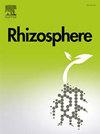种内植物-土壤反馈改变多年生禾本科根系性状
IF 3.5
3区 生物学
Q1 PLANT SCIENCES
引用次数: 0
摘要
干旱是植物及其相关微生物群面临的常见压力源。预估的气候数据表明,极端降水事件(如干旱)的严重程度和频率将会增加。先前的研究表明,长期暴露于干旱可以塑造植物的基因组,导致耐旱性的遗传变异。我们假设这些遗传变化也会影响根际微生物定植的模式,潜在地反馈影响植物对干旱的反应。在这里,我们测试了33种土壤,这些土壤由来自美国南部平原不同降水梯度的本地种群的33种基因型的短尾草(trisacum dactyloides)组成。以这33种土壤为接种剂,进行全因子试验,考察同种植物在干旱和丰水条件下对不同条件土壤的反应。地上部性状(如茎长、重量和根冠比)的变化主要由浇水处理来解释。然而,许多地下性状,如根系解剖和建筑性状,更有可能受到调节植物基因型的影响。在我们测量的性状中,只有通气面积受到当前浇水处理和调节植株基因型的交互作用的影响。最终,当前的浇水处理和调节植物基因型都改变了植物的生理性状和相关的微生物组。在恢复项目和农业系统中,由植物局部适应驱动的不同种内植物-土壤反馈动力学将是理解未来植物对快速变化的气候响应的关键。本文章由计算机程序翻译,如有差异,请以英文原文为准。
Intraspecific plant-soil feedbacks alter root traits in a perennial grass
Drought is a common stressor faced by plants and their associated microbiomes. Projected climate data point toward an increase in the severity and frequency of extreme precipitation events, such as droughts. Previous research has shown that long-term exposure to drought can shape plants' genomes, resulting in genetic variation for drought tolerance. We hypothesized that these genetic changes also affect patterns of microbial colonization in the rhizosphere, potentially feeding back to influence plant drought responses. Here, we tested 33 soils conditioned by 33 genotypes of Tripsacum dactyloides (eastern gamagrass) that originated from native populations across a precipitation gradient in the southern plains of the United States. We used these 33 soils as inocula for a fully factorial experiment to test the responses of conspecific plants to the differentially conditioned soils under drought or well-watered conditions. Variation in aboveground traits such as shoot length, weight, and root-to-shoot ratios was primarily explained by watering treatment. However, many belowground traits, such as root anatomical and architectural traits, were more likely to be affected by the genotype of the conditioning plant. Of the traits we measured, only aerenchyma area was affected by the interaction between current watering treatment and genotype of the conditioning plant. Ultimately, both the current watering treatment and conditioning plant genotype altered plant physiological traits and the associated microbiome. The differential intraspecies plant-soil feedback dynamics driven by plant local adaptation will be key to understanding future plants’ responses to rapidly shifting climates, in both restoration projects and agricultural systems.
求助全文
通过发布文献求助,成功后即可免费获取论文全文。
去求助
来源期刊

Rhizosphere
Agricultural and Biological Sciences-Agronomy and Crop Science
CiteScore
5.70
自引率
8.10%
发文量
155
审稿时长
29 days
期刊介绍:
Rhizosphere aims to advance the frontier of our understanding of plant-soil interactions. Rhizosphere is a multidisciplinary journal that publishes research on the interactions between plant roots, soil organisms, nutrients, and water. Except carbon fixation by photosynthesis, plants obtain all other elements primarily from soil through roots.
We are beginning to understand how communications at the rhizosphere, with soil organisms and other plant species, affect root exudates and nutrient uptake. This rapidly evolving subject utilizes molecular biology and genomic tools, food web or community structure manipulations, high performance liquid chromatography, isotopic analysis, diverse spectroscopic analytics, tomography and other microscopy, complex statistical and modeling tools.
 求助内容:
求助内容: 应助结果提醒方式:
应助结果提醒方式:


